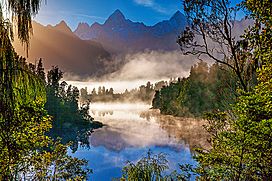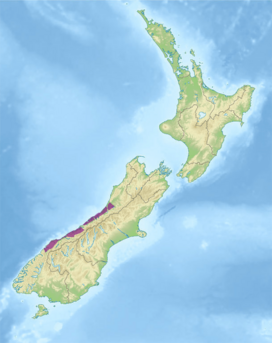Westland temperate forests facts for kids
Quick facts for kids Westland temperate forests |
|
|---|---|

|
|

Ecoregion territory (in purple)
|
|
| Ecology | |
| Realm | Australasian |
| Biome | temperate broadleaf and mixed forests |
| Borders | Fiordland temperate forests, Nelson Coast temperate forests, and Southland montane grasslands |
| Geography | |
| Area | 5,136 km2 (1,983 sq mi) |
| Country | New Zealand |
| Regions | West Coast |
| Coordinates | 43°42′S 169°27′E / 43.7°S 169.45°E |
| Conservation | |
| Protected | 4,311 km² (84%) |
The Westland temperate forests, also called the Westland temperate rainforests, are amazing natural areas. They are found on the central west coast of New Zealand's South Island, also known as Te Waipounamu. These special forests cover about 11,880 square kilometers. To the west, they meet the Tasman Sea, and to the east, they are bordered by the towering Southern Alps. A big part of these forests is protected within the beautiful Westland Tai Poutini National Park.
Contents
Exploring the Geography of Westland's Forests
New Zealand is a country made of two main islands. These are the North Island and the South Island. The Westland forests are on the central west coast of the South Island. To the south, you'll find the Fiordland temperate forests.
This area is home to many amazing glaciers. The Southern Alps mountains run along the coast. They cause a special weather effect called orographic lifting. This means that moist air from the sea is pushed up by the mountains. As it rises, it cools and forms clouds, leading to lots of rain and snow.
Many parts of New Zealand are protected to keep nature safe. The Westland region is especially rich in different kinds of plants and animals. This is called high biodiversity. Because New Zealand is so far away from other lands, it was one of the last places settled by people. The Māori lived here for a long time before Europeans arrived in the 1600s.
Westland's Amazing Glaciers
About 57 glaciers can be found in Westland National Park. They are all nestled within the Southern Alps. Two famous ones are the Franz Josef Glacier and the Fox Glacier. These glaciers are special because they reach down below the tree line. They get as low as 300 meters above sea level.
Over thousands of years, these glaciers have shaped the land. They carved out hills and ridges called moraines. The last big push forward by these glaciers was about 17,000 to 20,000 years ago. While many glaciers here haven't moved much lately, they have become thinner.
The Franz Josef Glacier starts high up in the mountains. Its upper part, called the névé, is about 2,700 meters above sea level. The glacier then flows down like a giant icy river. It reaches its lowest point at about 270 meters above sea level. The Waiho River flows from this area. The Franz Josef Glacier has changed its size many times over the last 100 years. It has both grown and shrunk.
The Fox Glacier is another impressive ice giant. It was first named the Albert Glacier by an explorer named Julius von Haast. Later, its name was changed to Fox. This was to honor Sir William Fox, who was a leader in the New Zealand colony. The Fox Glacier is located about 15 miles south of the Franz Josef Glacier.
Understanding Westland's Geology and Earthquakes
The Alpine Fault is a huge crack in the Earth's crust. It runs diagonally across New Zealand's South Island. This fault line goes right between the Southern Alps and the flat coastal areas. It even passes through Westland National Park.
The Alpine Fault is the biggest fault in New Zealand. It marks where two giant pieces of the Earth's surface meet. These pieces are called the Indo-Australian Plate and the Pacific Plate. They are always slowly moving, which can cause earthquakes.
Westland's Weather and Climate
New Zealand has a mild climate, meaning it's not too hot or too cold. The Westland forests get a lot of rain. On the coast, about 3,000 millimeters of rain falls each year. Near the Franz Josef and Fox glaciers, it's even more, about 4,700 millimeters. High up in the mountains, over 11,000 millimeters of precipitation can fall. This often comes as snow.
The Southern Alps cause this heavy rainfall through orographic lifting. This process was explained earlier. Because Westland is right by the coast, its weather is milder than places further inland. Most of the weather patterns are created by large air systems called anticyclones.
In summer, temperatures usually average around 20 °C. They can sometimes reach highs of about 30 °C. Snow rarely falls in the lower areas. However, it is very common at higher elevations, especially around the glaciers.
The Amazing Ecology of Westland
How Plants Change with Elevation (Zonation)
In Westland, the land quickly goes from flat areas to tall mountains. Because of this, the types of plants you see change a lot as you go higher. This is called zonation.
- Lowland Zone (0-400 meters): This area is mostly thick forest. You'll find climbing plants called lianas and plants that grow on other plants, known as epiphytes.
- Montane Zone (400-800 meters): This is also a forested area, but the trees might be different from the lowlands.
- Subalpine Zone (800-1200 meters): Here, the trees become shorter, and you'll see dense bushes and scrub.
- Low-Alpine Zone (1200-1500 meters): This zone has low bushes and tall grasses.
- High-Alpine Zone (1500-2000 meters): You'll find fields of small plants and short grasses here.
- Nival Zone (as low as 1700 meters): This is the highest zone. It has very few plants, mostly just lichens growing on rocks where there is no snow.
Plant Life and Forest Growth (Flora)
After a disturbance, like a glacier retreating, new life slowly returns. This process is called primary succession. It starts with tiny plants like mosses (such as Racomitrium) and algae (like Trentepohlia).
Then, small seedlings like willow-herbs and Raoulia start to grow. Over time, bigger plants appear, such as tree tutu (Coriaria arborea), broom (Carmichaelia arborea), and koromiko (Veronica salicifolia).
After about 20 years, young trees begin to grow. Early rata (Metrosideros) and kamahi (Pterophylla racemosa) trees are some of the first. As more plants grow, the soil becomes richer. This allows new species to move in. These include pate (Schefflera digitata), New Zealand broadleaf (Griselinia littoralis), and ferns like Zealandia pustulata and Blechnum capense. After many hundreds of years, tall podocarp forests finally grow.
Many of Westland's temperate forests have Nothofagus trees, also known as beech trees. In some places, where there are gaps between the beech trees, you might see heath plants and subalpine bushes.
The biggest areas of podocarp forest in Westland are found around 43° latitude. They grow from the western coast, along the Tasman Sea, all the way up to the Southern Alps. Forests with Rimu and kamahi trees are common here. You can also find mountain totara (Podocarpus laetus) and southern rata (Metrosideros umbellata).
Animal Life (Fauna)
Westland is home to many different birds. If you go birdwatching in Westland Tai Poutini National Park, you might see kea parrots, passerines, tomtits, fantails, and native pigeons. The pūkeko, spur-winged plover, and the famous kiwi bird also live in the Westland rainforest.
Sadly, human activity has greatly impacted many of these birds. Several species are now endangered or rare. About half of New Zealand's native forest birds have disappeared over time.
Many small animals also live in Westland. Plant-eaters include snails, slugs, worms, insect larvae, millipedes, and springtails. For the meat-eaters, there are many centipedes, ground beetles, and a huge number of spider species. Many ground spiders don't build webs. Instead, they use their speed and good eyesight to catch their prey.
A Look at Westland's History
The Māori lived along the Westland coast for many centuries. This was long before Europeans started to settle in New Zealand. Māori call this area Te Tai Poutini. The population was likely not very large, probably only a few hundred people at any time. Their homes were mostly small villages along the coast.
Food was plentiful in this region. Seafood was very important to the Māori. They smoked eels and sea fish, dried whitebait, and gathered seaweed and mussels. Other local foods included birds like duck and pigeon. The Māori were also skilled at working with stone. They used greenstone, a type of jade, which was often found near the Arahura River. It was also collected from other places like the Haast River and Lake Wakatipu.
Europeans first saw Westland in 1642. A Dutch sailor named Abel Janzoon Tasman spotted the mountain peaks from his ship. In 1770, Captain James Cook sailed around New Zealand and also saw the mountains along the coast. Glaciers were first noticed by sailors in 1859.
Interest in the area grew in the mid-1800s. The New Zealand Company explored Westland, hoping to find good land for new settlements. Over time, many explorers, including Charles Heaphy, Thomas Brunner, James McKay, and Julius von Haast, traveled through Westland. They often had Māori guides to help them.
In 1860, James McKay, working for the local government, bought a large part of the west coast from the Māori for 300 pounds. Four years later, in 1864, the discovery of gold brought thousands of miners to New Zealand. By the early 1900s, the gold rush had mostly ended. However, some negative effects from the search for gold remained.
In 1961, the Westland Tai Poutini National Park was created. Later, in 1982, more areas were added to the park. These included South Ōkārito, South Waikukupa, and parts of the Karangarua forests. This expansion happened because a new law helped show how important it was to protect these natural places.
What Affects Westland's Forests (Disturbances)
Human activities have been a major factor affecting the New Zealand Westland rainforest. In the past, the Māori sometimes set fires on purpose. These fires changed the forests on the South Island. Much of the forest on the east side of the island was replaced by grasslands because of this.
Both fires and logging have caused big changes in the Westland forest area. Today, there is no logging allowed in New Zealand's native forests. A large part of the temperate rainforest in Westland is now protected for conservation.
Some areas with rata-kamahi trees face a problem called "die-back." This is partly caused by opossums. These animals like to find shelter in older trees, especially those around 300 years old that grow in rich soil.
Changes in climate might affect Westland's temperate rainforests in the future. If droughts happen more often, there could be a higher risk of fires. This might cause the current rainforest plants to be replaced by plants that can survive fires.
Protecting Westland's Nature (Conservation)
Large parts of New Zealand are protected to keep nature safe. About 82% of the Westland ecoregion's land is in protected areas. Westland Tai Poutini National Park covers about 20,000 acres, or 81 square kilometers. About 25% of this park is made up of glaciers and snowfields.
Other protected areas that include parts of this ecoregion are Fiordland National Park, Mount Aspiring National Park, and Waitangiroto Nature Reserve. These parks and reserves help protect the unique plants and animals of Westland.
Fun Things to Do in Westland (Recreation)
Westland National Park offers many fun activities. You can go walking and hiking on many trails. These trails lead to beautiful lakes, streams, rivers, and bluffs.
Other activities include fishing, skiing, and boating. You can also take tours around and even on the local glaciers. It's a great place to explore and enjoy nature!

